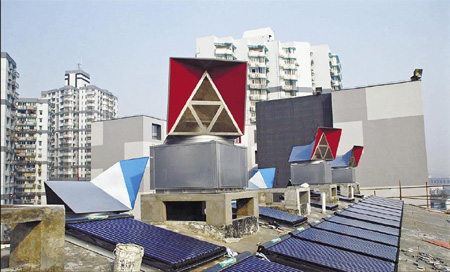China's ZED project to debut at the Shanghai Expo will leave no carbon footprint behind to show the world its commitment to battling climate change.
 |
|
A close look at the rooftop of the ZED pavilion, which features PV panels and wind cowls.
|
Imagine a 'green' utopia where people go about their daily lives ingesting the very utensils used to eat their meals so as not to disturb Mother Nature with even a morsel of waste.
That is the ideal being presented with a brand new building that has never before been constructed in China.
With restaurants that will serve food in bowls made of biscuit, the Zero Fossil Energy Development (ZED) project being erected as a pair of joint houses within the Urban Best Practices Area of the Shanghai Expo will stand as the nation's first-ever emissions-free public structure come May.
"The ZED pavilion will essentially be a collection of humankind's efforts in fighting climate change, and it will display our achievements in the endeavor," said Chen Shuo, who is coordinating efforts of the ZED project.
"Lowering carbon footprints should not just be the theme of the Shanghai Expo," he added. "It should be pursued beyond the May 1 to Oct 31 party."
With clay and beige-colored tones claiming its outer layer, the country is working to ensure the world that its environmental interests are not feigned inside the 2,500-sq-m structure set to showcase some of the most highly advanced green technologies.
Cathartically freeing it from a power-dependence on harmful pollutants like oil, the building has been designed to run on natural energies that will be derived from a combination of solar-driven power systems.
Twenty-two wind caps dotting the structure's rooftop will provide the building with ventilation to ensure visitors a comfortable stay during their tour.
Additionally, a special insular layer made from recycled materials will help lower the building's energy consumption levels. The insulation will help keep the building's indoor temperatures cooler during the summer while heat will be locked in during cold months.
Meanwhile, rainwater will be collected for irrigation and used for the building's washroom facilities.

